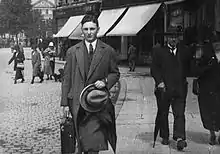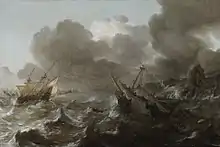Max Stern (gallery owner)
Max Stern (1904-1987) was a German-Canadian arts benefactor, art historian, and owner of Montreal's Dominion Gallery (in French, Galerie Dominion).

Life before WWII
Max Stern was born in München-Gladbach (today's spelling : Mönchengladbach), Germany, in April 1904. His father, Julius Stern, was a German-born Jew who worked in the textile industry, and later went into business as an art dealer. Before Max was born, his father was a prestigious art collector, and by World War I, had become one of the most prominent gallery owners in Düsseldorf.[1] For this reason, Max led a privileged childhood, immersed in Germanic culture. He had his family's full support in pursuing his doctoral studies in art history. He studied in Cologne, Berlin, Vienna and Paris, and earned his doctorate from the University of Bonn in 1928.[2] He then decided to become the Stern Gallery manager. His father died in 1934 and Max became the new gallery owner.[1]
During the war
Stern's ambitions grew once he became gallery owner. He hoped to one day operate galleries in Düsseldorf, London and New York City. Eventually with the help of his sister and the Dutch art historian Cornelius van de Wetering, Stern managed to open a gallery in London. The official opening occurred in 1935.[3]
Unfortunately, Stern's future plans were disrupted with the rise of Nazism in Germany. He received notification from the Reich Chamber of Fine Arts that he had lost his professional accreditation, and was given four weeks to either sell or dissolve all holdings within the Galerie Stern.[4] He appealed the mandate, while trying to find a suitable Aryan citizen to assume ownership. While the gallery was temporarily "Aryan", Stern planned to open another outside Germany and wait out the Third Reich.[4] To achieve these means, he chose Dutch art historian Nathan Katz.
Unfortunately, the Nazi Chamber of Fine Arts decided that the gallery was too important to fall into the hands of a foreigner, and would consider no future deals. In September 1937, Stern was given 17 days to close his business.[4] The reason for this forced closure was that all Jewish citizens had been forbidden from selling art. In November, Stern was forced to auction off a large segment of the Stern Gallery by order of the Nazi government. These artworks were sold in one of Germany's oldest auction houses, Kunsthaus Lempertz. They went on the block by their lot number, Auktion 392.[5] Not all pieces were sold, and Stern placed those that remained in storage with shipping agent Josef Roggendorf. Roggendorf held the artwork close to the Düsseldorf gallery until it was all confiscated by the National Socialist government.[2]
Stern then spent several years trying to track down the 28 confiscated paintings. He created an advertisement in the German art magazine Die Weltkunst, offering a reward for any information pertaining to the paintings' locations.[2] Recovering the paintings proved to be extremely difficult. Musical Party by Dirck Hals and Landscape with Figures by Salomon van Ruysdael were eventually recovered with help from the Canadian government after the war had ended. Last Judgment by Hieronymus Bosch was returned in 1954. Other works were never found.[2]
Post-war
Stern fled Germany in December, 1937, reportedly carrying nothing but a small suitcase. He decided to join his sister at the gallery in London. Their plans to develop further were interrupted a few years later once the war began. Stern was interred as an enemy alien in a refugee camp on the Isle of Man for two years.[2] The British government then allowed him to immigrate to Canada.[6] Stern sailed on the Polish liner Sobieski,[1] but was unable to get his money and belongings out of Britain. He then spent two years in internment camps in New Brunswick and Quebec.[2] He was given refugee status upon his arrival. He took steps to be exempted from this status, and made contact with the man who ran the Canadian Refugee Organization, William Birks, who immediately vouched for Stern.
Because of Stern's academic background and art dealing experience, he was named director of the Dominion Gallery of Fine Art. In January 1947, Stern and his wife became the sole proprietors of Gallery Dominion. He met his wife at the Canadian Refugee organization. She was a Swedish woman named Iris Westerberg.[7] Together, they made the gallery a focal point for the distribution of living art by Canadian artists. Both were known for promoting young and unknown Canadian art talents.
1944 was an especially important year for Stern's promotion of Canadian art. During this year, he held separate exhibitions featuring art by four members of the Group of Seven and Emily Carr.[8]
Stern made many important contributions towards Canadian art culture. In the 1940s he provided a means for young Canadian artists to paint on a full-time basis by establishing a contract system. In this system, monthly payments are made to the artist in exchange for an agreed number of works. This method has since been used successfully in France, England and the United States.[8]
In 1950, Stern moved the Dominion Gallery to a three-story building in a different area of Montreal. This new building allowed for 14 exhibition rooms and an apartment on the upper level where Stern and his wife would live.[9]
Legacy

Upon leaving Europe, Stern raised the level of art appreciation in Canada. He began donating to Canadian institutions in the mid-1950s, and gave generously to several museums across Canada. He was especially generous to Montreal institutions, donating over 166 works.[10]
True to his occupation until the very end, Stern died on a business trip in Paris. For his contributions he received countless acknowledgements and awards, including an honorary doctorate from Concordia University in 1985. The gallery continued to operate for more than a decade after Stern's death, closing in December 2000.[10]
The Max Stern Art Restitution Project was jointly created by the Hebrew University in Jerusalem, McGill University, Concordia University and the Holocaust Claims Processing Office in New York. The project's initiative has been to locate and recover works from the original Stern collection that were lost during the 1930s. The collection held an estimated 400 pieces in total.[11]
In 2017, a scheduled exhibition in Düsseldorf about Stern and the Restitution Project was abruptly cancelled due to local opposition, leading to intense controversy.[12]
Selected donated art pieces
- Painting: Pensive girl. Artist: Prudence Heward. Donated to: The Montreal Museum of Fine Arts.
- Painting: The Flayed Woman. Artist: Paul-Emile Borduas. Donated to: The Montreal Museum of Fine Arts.
- Painting: Little Girl in Blue. Artist: Jori Smith. Donated to: The Montreal Museum of Fine Arts.
- Painting: Woman on a Sofa. Artist: Kees Van Dongen. Donated to: The Montreal Museum of Fine Arts.
- Painting: Community House (Ucluelet). Artist: Emily Carr. Donated to: The Montreal Museum of Fine Arts.
References
- Pageot, Edith-Anne (2004). Max Stern : Montreal Dealer and Patron. Montreal: Montreal Museum of Fine Arts. p. 15.
- Dombowsky, Philip (2003). Dr. Max Stern and the Dominion Gallery a Selection from the Archives. Ottawa: National Gallery of Canada. p. 3.
- Dombowsky, Philip (2003). Dr. Max Stern and the Dominion Gallery a Selection from the Archives. Ottawa: National Gallery of Canada. p. 5.
- MacKenzie, Catherine Mary (2006). Auktion 392 : Reclaiming the Galerie Stern, Dèusseldorf. Montreal: Concordia University. p. 13.
- Leo Baeck Institute. ""Auktion 392" – Reclaiming the Galerie Stern". Federal Foreign Office. Retrieved 17 November 2013.
- Rossouw, Henk (2006). In Pursuit of an Art Dealer's Dream. The Chronicle of Higher Education.
- Pageot, Edith-Anne (2004). Max Stern : Montreal Dealer and Patron. Montreal: Montreal Museum of Fine Arts. p. 16.
- Dombowsky, Philip (2003). Dr. Max Stern and the Dominion Gallery a Selection from the Archives. Ottawa: National Gallery of Canada. pp. 5–6.
- Dombowsky, Philip (2003). Dr. Max Stern and the Dominion Gallery a Selection from the Archives. Ottawa: National Gallery of Canada. p. 6.
- Dombowsky, Philip (2003). Dr. Max Stern and the Dominion Gallery a Selection from the Archives. Ottawa: National Gallery of Canada. p. 7.
- Korte, Willi. "Dr. Max Stern and his Gallery and Art Collection from 1933-1945 and after World War II". Concordia University. Retrieved 22 November 2013.
- Angel, Sara (24 November 2017). "Restoration drama". The Globe and Mail. Retrieved 13 December 2017.
Dusseldorf's cancellation of show about Jewish art dealer Max Stern sparks outrage